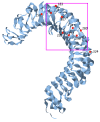Adaptive evolution and functional constraint at TLR4 during the secondary aquatic adaptation and diversification of cetaceans
- PMID: 22443485
- PMCID: PMC3384459
- DOI: 10.1186/1471-2148-12-39
Adaptive evolution and functional constraint at TLR4 during the secondary aquatic adaptation and diversification of cetaceans
Abstract
Background: Cetaceans (whales, dolphins and porpoises) are a group of adapted marine mammals with an enigmatic history of transition from terrestrial to full aquatic habitat and rapid radiation in waters around the world. Throughout this evolution, the pathogen stress-response proteins must have faced challenges from the dramatic change of environmental pathogens in the completely different ecological niches cetaceans occupied. For this reason, cetaceans could be one of the most ideal candidate taxa for studying evolutionary process and associated driving mechanism of vertebrate innate immune systems such as Toll-like receptors (TLRs), which are located at the direct interface between the host and the microbial environment, act at the first line in recognizing specific conserved components of microorganisms, and translate them rapidly into a defense reaction.
Results: We used TLR4 as an example to test whether this traditionally regarded pattern recognition receptor molecule was driven by positive selection across cetacean evolutionary history. Overall, the lineage-specific selection test showed that the dN/dS (ω) values along most (30 out of 33) examined cetartiodactylan lineages were less than 1, suggesting a common effect of functional constraint. However, some specific codons made radical changes, fell adjacent to the residues interacting with lipopolysaccharides (LPS), and showed parallel evolution between independent lineages, suggesting that TLR4 was under positive selection. Especially, strong signatures of adaptive evolution on TLR4 were identified in two periods, one corresponding to the early evolutionary transition of the terrestrial ancestors of cetaceans from land to semi-aquatic (represented by the branch leading to whale + hippo) and from semi-aquatic to full aquatic (represented by the ancestral branch leading to cetaceans) habitat, and the other to the rapid diversification and radiation of oceanic dolphins.
Conclusions: This is the first study thus far to characterize the TLR gene in cetaceans. Our data present evidences that cetacean TLR4 has undergone adaptive evolution against the background of purifying selection in response to the secondary aquatic adaptation and rapid diversification in the sea. It is suggested that microbial pathogens in different environments are important factors that promote adaptive changes at cetacean TLR4 and new functions of some amino acid sites specialized for recognizing pathogens in dramatically contrasted environments to enhance the fitness for the adaptation and survival of cetaceans.
Figures



Similar articles
-
Distinct evolution of toll-like receptor signaling pathway genes in cetaceans.Genes Genomics. 2019 Dec;41(12):1417-1430. doi: 10.1007/s13258-019-00861-3. Epub 2019 Sep 18. Genes Genomics. 2019. PMID: 31535317
-
Evolution of toll-like receptors in the context of terrestrial ungulates and cetaceans diversification.BMC Evol Biol. 2017 Feb 16;17(1):54. doi: 10.1186/s12862-017-0901-7. BMC Evol Biol. 2017. PMID: 28209121 Free PMC article.
-
Adaptive evolution of the osmoregulation-related genes in cetaceans during secondary aquatic adaptation.BMC Evol Biol. 2013 Sep 9;13:189. doi: 10.1186/1471-2148-13-189. BMC Evol Biol. 2013. PMID: 24015756 Free PMC article.
-
Molecular evolution tracks macroevolutionary transitions in Cetacea.Trends Ecol Evol. 2014 Jun;29(6):336-46. doi: 10.1016/j.tree.2014.04.001. Epub 2014 May 1. Trends Ecol Evol. 2014. PMID: 24794916 Review.
-
The evolution of foraging capacity and gigantism in cetaceans.J Exp Biol. 2018 Jun 12;221(Pt 11):jeb166033. doi: 10.1242/jeb.166033. J Exp Biol. 2018. PMID: 29895582 Review.
Cited by
-
TLR4 and TLR8 variability in Amazonian and West Indian manatee species from Brazil.Genet Mol Biol. 2021 Apr 9;44(2):e20190252. doi: 10.1590/1678-4685-GMB-2019-0252. eCollection 2021. Genet Mol Biol. 2021. PMID: 33847701 Free PMC article.
-
Evolutionary Genetics of Hypoxia Tolerance in Cetaceans during Diving.Genome Biol Evol. 2016 Feb 24;8(3):827-39. doi: 10.1093/gbe/evw037. Genome Biol Evol. 2016. PMID: 26912402 Free PMC article.
-
Multi-Omics Approaches and Radiation on Lipid Metabolism in Toothed Whales.Life (Basel). 2021 Apr 20;11(4):364. doi: 10.3390/life11040364. Life (Basel). 2021. PMID: 33923876 Free PMC article. Review.
-
Integrated Full-Length Transcriptome and RNA-Seq to Identify Immune System Genes from the Skin of Sperm Whale (Physeter macrocephalus).Genes (Basel). 2021 Feb 5;12(2):233. doi: 10.3390/genes12020233. Genes (Basel). 2021. PMID: 33562637 Free PMC article.
-
The Analyses of Cetacean Virus-Responsive Genes Reveal Evolutionary Marks in Mucosal Immunity-Associated Genes.Biochem Genet. 2022 Dec;60(6):2299-2312. doi: 10.1007/s10528-022-10221-8. Epub 2022 Mar 25. Biochem Genet. 2022. PMID: 35334059 Free PMC article.
References
-
- Smith KD, Andersen-Nissen E, Hayashi F, Strobe K, Bergman MA, Barrett SL, Cookson BT, Aderem A. Toll-like receptor 5 recognizes a conserved site on flagellin required for protofilament formation and bacterial motility. Nat Immunol. 2004;4:1247–1253. - PubMed
-
- Barreiro LB, Ben-Ali M, Quach H, Laval G, Patin E, Pickrell JK, Bouchier C, Tichit M, Neyrolles O, Gicquel B, Kidd JR, Kidd KK, Alcais A, Ragimbeau J, Pellegrini S, Abel L, Casanova JL, Quintana-Murci L. Evolutionary dynamics of human Toll-like receptors and their different contributions to host defense. PLoS Genet. 2009;5:e1000562. doi: 10.1371/journal.pgen.1000562. - DOI - PMC - PubMed
Publication types
MeSH terms
Substances
LinkOut - more resources
Full Text Sources

